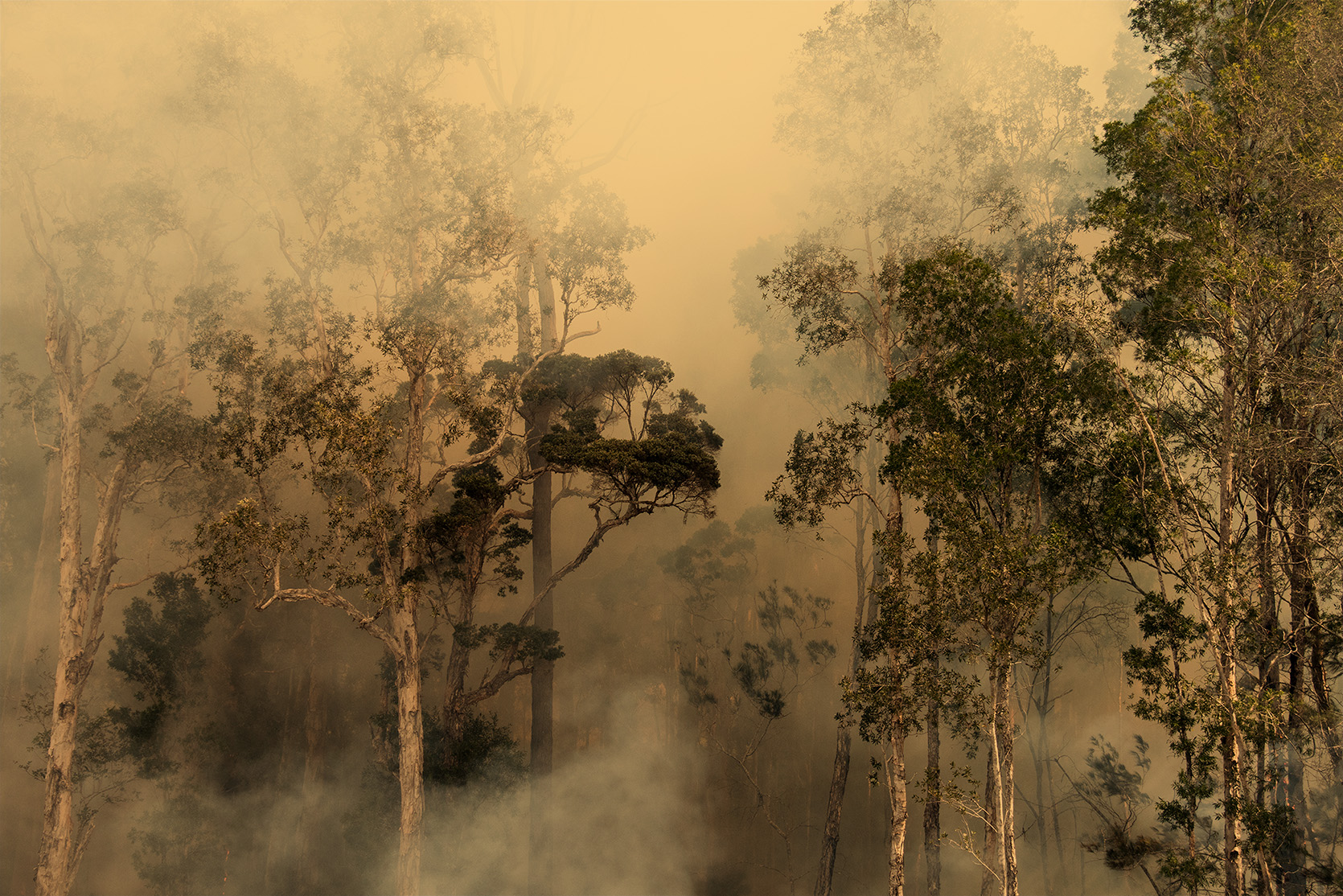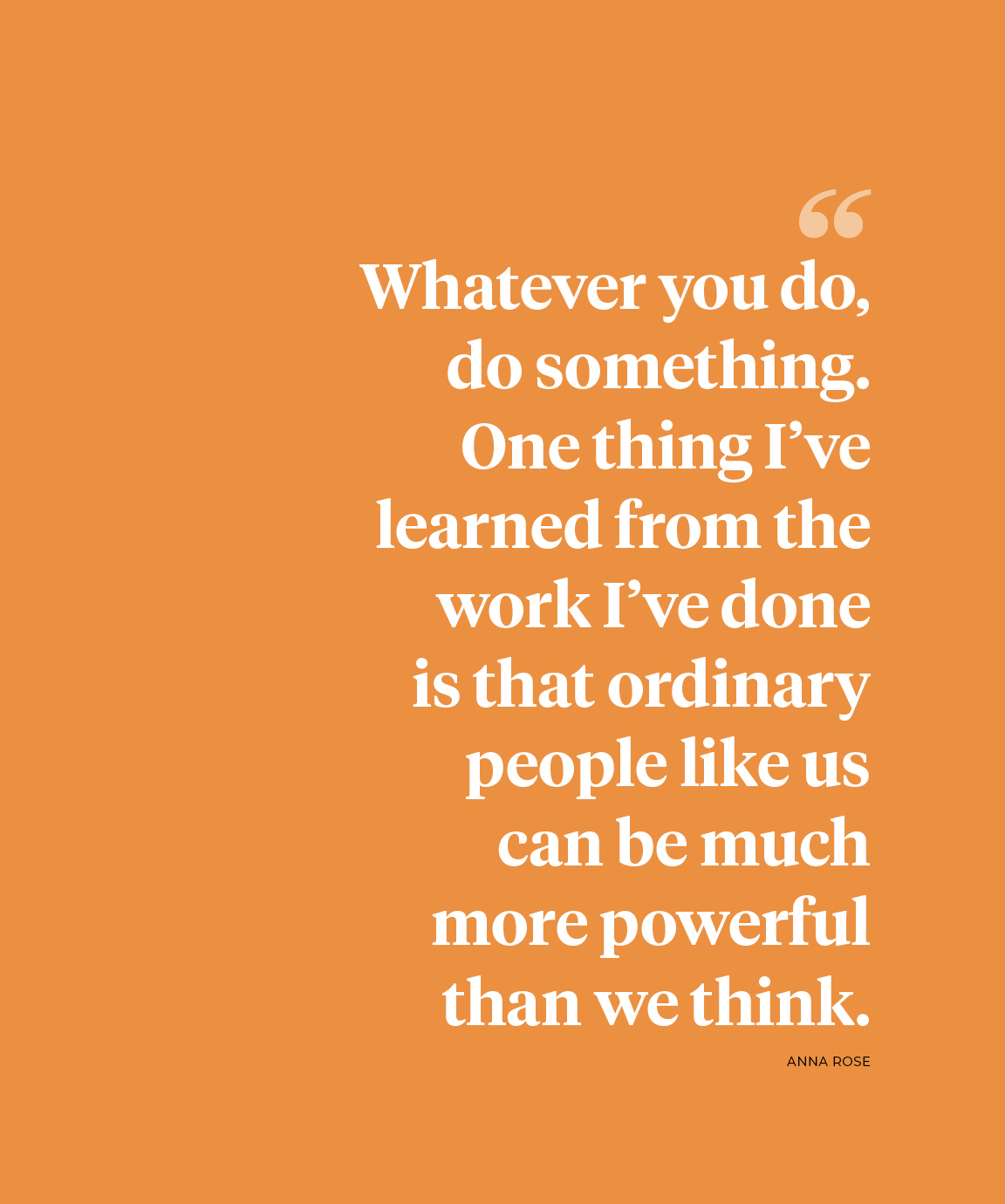
The Climate Crisis – How to Make an Impact
In Issue 45, author and climate campaigner Anna Rose explained how we all have more power than we think when it comes to influencing and creating real change.
When I was four years old, a landmark paper was published by eminent CSIRO scientist Dr Tom Beer. Titled ‘Australian bushfire danger under changing climatic regimes’, the paper demonstrated how climate change impacts could lead to changes in the intensity of bushfire seasons. Back then, it didn’t attract the headlines it deserved, let alone capture the attention of the politicians who were supposed to be in charge of protecting Australians and planning for our future.
Years later, as a teenager getting involved in the early days of the climate movement, I read Dr Beer’s paper – one among many scientific predictions warning what would happen to Australia if we, and the rest of the world, didn’t reduce carbon pollution. Coming from a farming family, the research that stuck with me most was on drought and changing rainfall patterns, but the spectre of megafires was always present at the back of my mind.
Dr Beer went on to become the leader of the Climate Variability and Change research program at CSIRO, where he worked for three decades. I went on to become an environmental campaigner, and now have a four-year-old child of my own. To recap: a paper published when I was in preschool warning that megafires would destroy our rural and regional communities was basically ignored by politicians and the media until the point its predictions played out in real life, 30 years later. This was enough time for a child at the time the paper was published to grow up and have a child of her own. And still our governments are not taking climate change seriously.

My son started preschool yesterday; he was so excited. But as we walked from the bus stop and he skipped the last few metres to the gate with a huge smile on his tiny face, I worried. Not about the things my mum would have worried about on my first day of preschool, but about the air quality index, which was hovering between ‘moderate’ and ‘unhealthy for sensitive groups’ because of bushfire smoke. Would the kids be running around outside? What would the long-term implications be for my son’s health? Researchers have shown there is no safe level of exposure to elevated particulate pollution.
For the entire time I’ve been alive, and particularly in the years since my son was born, the Australian government has been clearly warned that climate change would create unprecedented hot and dry conditions – the exact conditions that have made these fires so severe. These warnings have come not just from scientists and the general public who listen to them, but also from former fire chiefs – hardly a group that can be dismissed as activists. In the words of former NSW Fire Commissioner Greg Mullins: “We have to talk about climate change because our bushfire season in Australia has changed forever.”
We have to talk about climate change because our bushfire season in Australia has changed forever.
Scientists warn we have between 10 to 12 years to turn things around on climate change – to reduce emissions, globally, to levels that will limit temperature rise to two degrees above pre-industrial levels. Right now we are on track to three or four degrees of warming by the end of the century. These unprecedented fires have happened in a climate that’s been changed by just one degree of warming.
In the hours between preschool dropoff and pickup, I’m a climate change campaigner. For over two decades, I’ve worked to try to help Australia make progress tackling climate change. Over the years, I’ve approached the problem from various angles. Things I’ve been involved in include co-founding a youth movement (the Australian Youth Climate Coalition); communicating climate change to mainstream Australians through co-starring in a TV show and writing a book; running Earth Hour with WWF Australia; and supporting groups including farmers, parents, musicians, athletes, surfers, health professionals, the Jewish community and many others to get active on climate change. I’ve also been involved in the divestment movement, including helping my husband set up Australia’s first fossil-fuel-free superannuation fund, Future Super. Most recently, some friends and I co-founded Groundswell, Australia’s first giving circle that helps people co-fund strategic climate advocacy work together.
Since the fires, the number of times a day that people reach out to me asking for advice or assistance in making an impact on climate change has quadrupled. Most of these people are totally new to engaging in the issue of climate change, and everyone starts with a simple question: what can I do? Everyone wants a list; a silver bullet, or five. But just like other things that are important in your life – getting fit or being a good parent, for example – making an impact on climate change is different for each person. It’s going to take time and commitment, but how you do it best depends on your skills, interests, resources and network. There is no one-size answer to the question “what can I do”, just as there’s no one-size answer to the question “how can I get fit”.
The most useful resource I give people is a framework and strategy paper written by my friend Sam La Rocca, now deputy director of environmental group The Sunrise Project. The framework was created as part of a strategy review led by Climate Action Network Australia, the body that helps the dozens of different organisations involved in climate activism to communicate and coordinate. According to this framework, four major pieces of work are required if we’re going to make progress on climate change in Australia: build a movement, change the story, shift the money and change the politics.
The first prong is movement building. Politicians only ever aim as high as their citizens demand. Business only takes a stand when their customers demand it, or their brand is at risk. And that’s where advocacy and campaigning comes in. It’s going to take strategic and well-resourced advocacy to get our political leaders to reduce emissions to levels that will play a genuine part in avoiding the worst impacts of climate change. We need hundreds of groups building a social movement powerful enough to force governments to deal with the causes of the climate crisis, such as coal and gas, not just the symptoms. The main piece of advice any experienced climate campaigner will give you when you ask what you should do is to get involved in, and raise funds for, climate advocacy groups.
As writer Rebecca Solnit said in a piece on the climate crisis: “We can do it. And we is the key word here. The world is not going to be saved by individual acts of virtue; it’s going to be saved, if it is to be saved, by collective acts of social and political change. Mass movements work. Unarmed citizens have changed the course of history countless times in the modern era. When we come together as civil society, we have the capacity to transform policies, change old ways of doing things, and sometimes even topple regimes. And it is about governments. Like it or not, the global treaties, compacts, and agreements we need can only be made by governments, and governments will make those agreements when the pressure to do so is greater than the pressure not to. We can and must be that pressure.”
The world is not going to be saved by individual acts of virtue; it’s going to be saved, if it is to be saved, by collective acts of social and political change.
There are so many groups you can support with your time and money, from specific climate advocacy groups for young people, psychologists, health professionals, farmers and vets to parents, surfers, athletes, the fashion industry, business, local councils and more. You can see a directory of Climate Action Network Australia members on their website, which is a good place to start.
The second chunk of work involves changing the story. Research from the Australian National University in 2014 showed that 30% of Australians either did not know who to trust (21%) or did not trust anyone (9%) when it came to sources of accurate information about science. When asked unprompted, respondents identified friends and family (12%) and CSIRO (also 12%) as the most commonly mentioned trusted sources. So even though you’re probably not a CSIRO scientist, it turns out you’re just as influential as one when it comes to providing information about climate change to people you know!
That’s why it’s so powerful to bring up climate change and environmental issues with friends, colleagues, family and acquaintances. You can do this each and every day in casual interactions or a more structured way. Many people are now hosting climate change kitchen table conversations or dinner parties as a way to get their friends and colleagues more engaged, and Damon Gameau’s 2040 is an excellent film focused on climate solutions that you can use to kick off a conversation.
A great way to help change the story on a larger scale is to be part of the transition to renewable energy. If you own your own home, consider getting solar panels and battery storage, and at work, encourage your management team to sign up to RE100 – a global movement of businesses committing to transition to 100% renewable energy, often through power purchase agreements (bonus: this will reduce your energy bill). Once you’ve done something yourself to be part of the energy transition, it’s a great conversation starter!
The third part of Sam’s framework involves shifting the money. As the author and campaigner Bill McKibben wrote in a New Yorker article entitled ‘Money is the oxygen on which the fire of global warming burns’: “I suspect that the key to disrupting the flow of carbon into the atmosphere may lie in disrupting the flow of money to coal and oil and gas.”
Seven years ago, the organisation Bill founded, 350.org, launched a global divestment campaign to pressure managers of large pots of money – including superannuation funds, as well as university and philanthropic foundation endowments – to sell their stocks in fossil fuel companies. As Bill writes, it has become the largest such campaign in history: funds worth more than eleven trillion dollars have divested some or all of their fossil fuel holdings.
Now, Bill’s attention – and that of many of the world’s smartest climate campaigners – is turning to, in his words, “extending the logic of the divestment fight one ring out, from the fossil fuel companies to the financial system that supports them.” The second phase of the divestment movement is focusing on banks, asset managers and insurance companies. If the fossil fuel projects that drive climate change can’t get money, investors or insurance, they can’t proceed. This new strategy is already making progress. BlackRock is the world’s largest fund manager. In January, it announced that it will dump more than half a billion dollars in thermal coal shares from all of its actively managed portfolios – excluding all companies that generate more than 25% of their revenue from thermal coal production. CEO Larry Fink announced BlackRock will “put climate change at the centre of its investment strategy” and noted that climate change has become the top issue raised by clients.
According to economist John Quiggin, Professor at The University of Queensland, this is part of a major global trend. Writing in The Conversation, he says: “Virtually all the major Australian and European banks and insurers, and many other global institutions, have already announced such policies. And according to the Unfriend Coal Campaign, insurance companies have stopped covering roughly US$8.9 trillion of coal investments – more than one third (37%) of the coal industry’s global assets, and stopped offering reinsurance to 46% of them.”

So if you’re part of the finance or insurance sector, there’s a big role for you to play in shifting the money out of coal and gas. But what about other sectors? Lawyers can campaign for their firms to refuse to work with fossil fuel clients; management consultants and auditors can do the same. Caterers, conference centres and hospitality workers can refuse to service fossil fuel events. If our governments are too slow to act, we can all be part of removing the services and the social licence that fossil fuel companies depend on to operate. There’s a new platform called ‘WorkForClimate’ that will help you with resources and support for people who want to be climate change agents of change, working inside their workplaces at an executive team level.
In addition to corporate campaigning and influencing your employer, you can make sure your own money isn’t being used to invest in fossil fuels. The big four Australian banks are huge lenders to the fossil fuel industry, but they do take notice of consumer concerns – for example, all four ruled out lending to the Adani coal mine. That was a great victory for people power, yet the big four banks continue to lend billions of dollars to other fossil fuel projects, so it’s worth switching to a fossil-free bank.
Your superannuation is another way to make a big impact. Over half of the world’s superannuation is invested in fossil fuels and other high-carbon sectors, while less than two percent is invested in climate solutions like renewable energy. If super funds switched even a fraction of their investments to renewables, it would completely transform the energy industry. In Australia, nearly all super funds contain investments in fossil fuel companies as well as companies that enable the fossil fuel industry. When the superannuation industry moves, it sends a strong message to the rest of the investment community that there’s no long-term future in fossil fuels.
If super funds switched even a fraction of their investments to renewables, it would completely transform the energy industry.
Finally, we have to change the politics. Halting damage to our climate requires new laws at every level of government, which requires politicians to take the issue seriously. One crucially important thing you can do is to call your state and federal members of parliaments’ electorate offices and book in a face-to-face meeting with each member. Talk with them about your concerns that parliament is not doing enough to reduce damage to our climate. Build a relationship with them. Visit them a few times a year. Send them interesting news articles about climate change and renewable energy. Organise a community forum on climate change and ask them to speak to their constituents about the issue.
At this point, you might have an image of Scott Morrison cradling a lump of coal in parliament popping into your head (sorry!). But politics is so much more than our federal government, so while we do need to keep the pressure on there, it’s important to also engage at the state and local levels.
Engaging with your local council might not immediately spring to mind as something you can imagine yourself doing, but around the world and across Australia, towns and cities of all shapes and sizes are getting on with the job of climate action. They are surging ahead with emission reduction plans, switching to cleaner energy and building greener, efficient and more resilient communities. From booming urban centres to small rural townships, local governments and groups of determined residents have been energy and climate trailblazers in many ways. Towns and cities can shape how land is used, investments are made and millions of dollars worth of renewable energy is rolled out. Local governments can influence how new homes and businesses are built, determine the ways in which hundreds of thousands of residents will travel each day and band together to lobby for much-needed state and federal policy change. Transforming the way cities use and generate energy alone has the potential to deliver 70% of the total emission reductions needed to stay on track for the two-degree limit set under the Paris Agreement. As a citizen, you can have a lot of influence and engagement with your local council, providing encouragement and asking them to join the Climate Council’s Cities Power Partnership. You can even decide to run at your next council election!

So there you have it: a framework for you to think about how you can use your influence to tackle climate change. To recap…
Are you the kind of person who likes to get involved in groups, or has the ability to raise a lot of money? Focus on building the movement by joining and fundraising for climate advocacy organisations.
Are you someone with the ability to influence institutions with large amounts of capital being invested, like the endowment of a university, foundation or religious institution? Or are you involved in banking, asset management or the insurance industry? If so, the divestment movement is for you.
Have you got the gift of the gab, a large network of people in your life or a talent for communicating things in new ways? Focus on changing the story.
Are you willing to get engaged in the political sphere, meet with your politicians (again and again) at state, federal and local levels – and even consider joining a political party yourself to influence change from within? Then get ready for a wild ride and pick changing the politics.
I hope that in the course of reading this, it’s become clear that there are myriad ways you can be useful in helping Australia make progress tackling climate change. Whatever you do, do something. One thing I’ve learned from the work I’ve done is that ordinary people like us can be much more powerful than we think.
When I was a teenager, in addition to reading depressing scientific papers about climate change, I read Nelson Mandela’s book Long Walk to Freedom. Despite being imprisoned for 27 years, he understood how powerful one life can be. Two quotes have stuck with me ever since. The first speaks to the power we have to make change when we decide to be brave and get out of our comfort zone: “And as we let our own light shine, we unconsciously give other people permission to do the same.”
The second: “It always seems impossible until it is done.”


